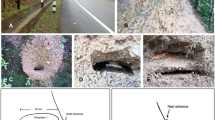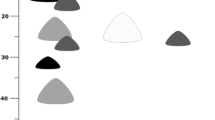Abstract
The mating behaviour of the ant Rossomyrmex minuchae, a rare, protected slave-making species in Spain, seems to be significantly affected by its particular life history and patchy habitat. The mating behaviour of the entire genus Rossomyrmex is virtually unknown. We present here the results of a 3-year study of mating behaviour in R. minuchae.
Behavioural observations and limited nest excavations revealed that R. minuchae does not produce sexuals every year, the number of sexuals is low, and the sex ratio tends to be female biased. Females typically exhibit two distinct activity periods. The first, the mating period, takes place in early afternoon: the ants “call” near the natal nest, mate and then return to their nest. The second, the dispersal period takes place in late afternoon: the mated females exit their nest and fly in search of a new, non-parasitized Proformica longiseta host nest. Males are highly active during the mating period, but will remain inactive in the dispersal period even if experimentally presented with virgin females. It appears that females are monogamous, while males are polygamous. When males are late arriving at the female calling site, the females will frequently congregate presumably calling in chorus.
The low reproductive efficiency exhibited by R. minuchae, coupled with the postulated low genetic variation in the population, as sisters may mate with the same male, could result in a low survival rate and risk of eventual extinction. The observed decrease in nest density we observed during the 2004 season may be indicative of such a process.

Similar content being viewed by others
References
Bourke AFG, Franks NR (1995) Social evolution in ants. Princeton University Press, Princeton, NJ
Bourke AFG, Van der Have TM, Franks NR (1988) Sex ratio determination and worker reproduction in the slave-making ant Harpagoxenus sublaevis. Behav Ecol Sociobiol 23:233–245
Crozier RH, Page RE (1985) On being the right size: male contributions and multiple mating in social Hymenoptera. Behav Ecol Sociobiol 18:105–115
D’Etorre P, Heinze J (2001) Sociobiology of slave-making ants. Acta Ethol 3:67–82
Fernández-Escudero I, Pamilo P, Seppä P (2002) Biased sperm use by polyandrous queens of the ant Proformica longiseta. Behav Ecol Sociobiol 51:207–213
Greenberg L, Aliabadi A, Mcelfresh JS, Topoff H, Millar JG (2004) Sex pheromone of queens of the slave-making ant Polyergus breviceps. J Chem Ecol 30:1297–1303
Hasegawa E, Ruano F, Tinaut A (2002) Molecular phylogeny of two slave-maker ants: Rossomyrmex and Polyergus (Hymenoptera: Formicidae). Ann Zool Fenn 39:267–271
Hölldobler B, Bartz SH (1985) Sociobiology of reproduction in ants. Progress in Zoology 31:237–257
Keller L, Reeve, HKL (1994) Partitioning of reproduction in animal societies. Trends Ecol Evol 9:98–102
Lenoir A, Querard L, Pondicq N, Berton F (1988) Reproduction and dispersal in the ant Cataglyphis cursor (Hymenoptera, Formicidae). Psyche 95:21–44
Mori A, D’Ettorre P, Le Moli F (1994) Mating and post-mating behaviour of the European amazon ant, Polyergus rufescens (Hymenoptera, Formicidae). Boll Zool 61:203–206
Ruano F, Tinaut A (1999) Raid process, activity pattern and influence of abiotic conditions in Rossomyrmex minuchae (Hymenoptera: Formicidae), a slave-maker species. Insect Soc 46:341–347
Savolainen R, Seppä P (1996) Genetic relatedness among worker nestmates of three formicine slave-making ants. Insect Soc 43:31–36
Schmid-Hempel P, Crozier RH (1999) Polyandry versus polygyny versus parasites. Philos Trans Roy Soc Lond B 354:507–515
Talbot M (1968) Flights of the ant Polyergus lucidus Mayr. Psyche 75:46–52
Topoff H, Greenberg L (1988) Mating behaviour of the socially parasitic ant Polyergus breviceps: the role of the mandibular glands. Psyche 95:81–87
Acknowledgements
The DGICYT funded this work PB94-0768 (1995-98). We thank Abraham Hefetz for helpful discussions and revision on the manuscript, and Naomi Paz for editing the English. We thank the authorities of the National Park of Sierra Nevada for granting permission to conduct our study there. This study complies with Spanish laws on wildlife conservation
Author information
Authors and Affiliations
Corresponding author
Rights and permissions
About this article
Cite this article
Ruano, F., Tinaut, A. Mating behaviour in a slave-making ant, Rossomyrmex minuchae (Hymenoptera, Formicidae). Naturwissenschaften 92, 328–331 (2005). https://doi.org/10.1007/s00114-005-0633-1
Received:
Accepted:
Published:
Issue Date:
DOI: https://doi.org/10.1007/s00114-005-0633-1




